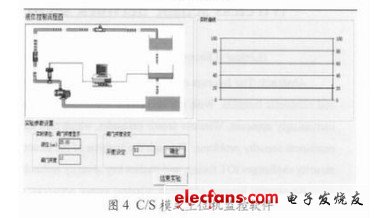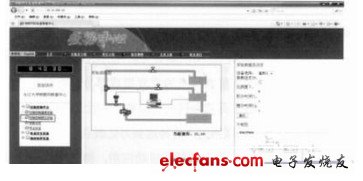At present, many fields need to monitor water level, oil tank level, boiler level, etc. However, in traditional level control systems, the industrial site and the control room are connected via wired mode for signal transmission, which has obvious defects, such as high installation and debugging costs, troublesome cable laying, and complicated other interference factors.
In order to solve the troubles caused by the wired mode in the traditional liquid level control system, the liquid level process control experimental platform based on ZigBee short-range wireless communication is adopted. It can overcome the shortcomings of the current wired mode and reduce the cost of installation, debugging and maintenance. Therefore, it will definitely become the mainstream in the future process control experimental platform market.
The core technology of ZigBee can be attributed to wireless sensor network technology, which has the advantages of low cost, low power consumption, and convenient expansion. Its network structure is flexible and changeable, and the sensing monitoring range is wide. Monitoring points can be added at any time without wiring. Therefore, wireless sensor networks have broad application prospects in military, agriculture, industry, medicine, home life and entertainment.
This system is a wireless liquid level process control device designed on the basis of ZigBee wireless sensor network technology, which conforms to the development trend of intelligent, wireless and networked sensors.
1 Overall system design
This system transmits the information of the CS-E type liquid level process control device to the database through ZigBee wireless technology. On the one hand, operators and users can access the database through PC applications or web pages to monitor the liquid level sensor information in real time. On the other hand, operators can also send control instructions through the PC, which reach the liquid level control node through the ZigBee network and then achieve the purpose of liquid level control through the actuator. The structure diagram of the liquid level process control device is shown in Figure 1.
Figure 1 Structure diagram of liquid level process control device
Figure 2 System Block Diagram
2 System Hardware Integration Design
The wireless liquid level process control system is mainly composed of liquid level sensor, control actuator, wireless data transmission (terminal node), central control, upper computer liquid level display and other parts. The system block diagram is shown in Figure 2.
The liquid level data collected by the liquid level sensor can be transmitted to the terminal node through the serial port, and the terminal node can then send it to the central control through wireless data transmission. The central control combines with the host computer application to display the liquid level data in real time.
According to the functional division, this system is mainly composed of terminal nodes and central control. The terminal nodes mainly complete the collection, control execution and wireless transmission functions of liquid level data. The central control mainly completes the functions of data processing, liquid level display, control command generation and release, etc.
The terminal node is mainly composed of ZigBee node, valve, power supply, antenna, liquid level sensor and other parts. This system uses CS-E type pressure level transmitter, and the liquid level data collected by the liquid level sensor is sent to the central node through wireless transmission via the terminal node. After receiving the control signal from the central node and judging and processing it by the host computer, the system can send the corresponding control command to control the valve.
The central control is mainly composed of ZigBee coordinator, router, power supply, antenna, upper computer liquid level display and other parts. ZigBee coordinator is responsible for networking all ZigBee nodes, and router is used to extend the wireless transmission distance. The terminal node forwards the collected liquid level data to the ZigBee coordinator through the routing node, and the coordinator transmits it to the background database through the serial port. Finally, the upper computer judges and processes the data and displays the liquid level data. At the same time, it generates corresponding control instructions and sends them to the terminal node.
The ZigBee node and coordinator chip both use CC2530, which is a true system-on-chip compatible with IEEE 802.15.4 and supports proprietary 802.15A as well as ZigBee, ZigBee PRO and ZigBeeRF4CE standards.
3 System software design and development
According to the requirements of liquid level monitoring, monitoring programs based on C/S and B/S modes can be designed respectively to display parameters such as liquid level value and valve opening in real time. The overall system program flow chart is shown in Figure 3, and the monitoring program effect diagrams are shown in Figures 4 and 5.
Figure 3 Program flow chart 
Figure 4 C/S mode host computer monitoring software
Figure 5 B/S mode web monitoring center
4 Conclusion
The greatest significance and highlight of this design is to introduce ZigBee wireless sensor technology into the traditional wired mode liquid level process control experimental platform, thus overcoming some of the disadvantages of the current wired mode and reducing the cost of installation, commissioning and maintenance. This is the first time in China that ZigBee wireless sensor technology has been applied to the control experimental platform of the liquid level process. This design can be said to be an important model change in the field of process control, which will definitely have a certain impact on the field of process control.
Previous article:Smart cities kick off a new round of investment boom in the information sector
Next article:Design and implementation of communication between industrial computer and inverter based on labview
- Popular Resources
- Popular amplifiers
- High signal-to-noise ratio MEMS microphone drives artificial intelligence interaction
- Advantages of using a differential-to-single-ended RF amplifier in a transmit signal chain design
- ON Semiconductor CEO Appears at Munich Electronica Show and Launches Treo Platform
- ON Semiconductor Launches Industry-Leading Analog and Mixed-Signal Platform
- Analog Devices ADAQ7767-1 μModule DAQ Solution for Rapid Development of Precision Data Acquisition Systems Now Available at Mouser
- Domestic high-precision, high-speed ADC chips are on the rise
- Microcontrollers that combine Hi-Fi, intelligence and USB multi-channel features – ushering in a new era of digital audio
- Using capacitive PGA, Naxin Micro launches high-precision multi-channel 24/16-bit Δ-Σ ADC
- Fully Differential Amplifier Provides High Voltage, Low Noise Signals for Precision Data Acquisition Signal Chain
- LED chemical incompatibility test to see which chemicals LEDs can be used with
- Application of ARM9 hardware coprocessor on WinCE embedded motherboard
- What are the key points for selecting rotor flowmeter?
- LM317 high power charger circuit
- A brief analysis of Embest's application and development of embedded medical devices
- Single-phase RC protection circuit
- stm32 PVD programmable voltage monitor
- Introduction and measurement of edge trigger and level trigger of 51 single chip microcomputer
- Improved design of Linux system software shell protection technology
- What to do if the ABB robot protection device stops
- Allegro MicroSystems Introduces Advanced Magnetic and Inductive Position Sensing Solutions at Electronica 2024
- Car key in the left hand, liveness detection radar in the right hand, UWB is imperative for cars!
- After a decade of rapid development, domestic CIS has entered the market
- Aegis Dagger Battery + Thor EM-i Super Hybrid, Geely New Energy has thrown out two "king bombs"
- A brief discussion on functional safety - fault, error, and failure
- In the smart car 2.0 cycle, these core industry chains are facing major opportunities!
- The United States and Japan are developing new batteries. CATL faces challenges? How should China's new energy battery industry respond?
- Murata launches high-precision 6-axis inertial sensor for automobiles
- Ford patents pre-charge alarm to help save costs and respond to emergencies
- New real-time microcontroller system from Texas Instruments enables smarter processing in automotive and industrial applications
- The CH579 environment was successfully built and the first program was downloaded successfully, perfect.
- LPC4357 internal EEPROM read and write problem
- Patch Microstrip Filter Example
- 【AT-START-F425 Review】USB to CAN Part 3
- 2.4-GHz Bluetooth low energy and proprietary system-on-chip
- [Synopsys IP Resources] CDC Verification: One of the Biggest Challenges in Multi-Billion-Gate ASIC Design
- Want to buy Dahua DH-PHSA1.2-SH and DH-PHSA1.5-SH LED modules
- Microphone sound signal extraction and processing
- 5G will change the way we surf the Internet. Will each of us have a small base station?
- Learning to use FPGA to implement video and image processing design

 ALD2706PAXXXX
ALD2706PAXXXX
















 京公网安备 11010802033920号
京公网安备 11010802033920号